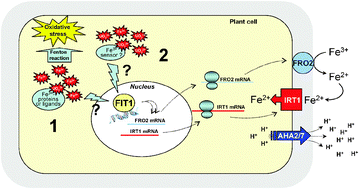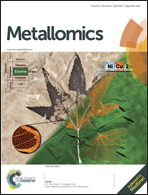Uranium perturbs signaling and iron uptake response in Arabidopsis thaliana roots†
Abstract
Uranium is a natural element which is mainly redistributed in the environment due to human activity, including accidents and spillages. Plants may be useful in cleaning up after incidents, although little is yet known about the relationship between metal speciation and plant response. Here, J-Chess modeling was used to predict U speciation and exposure conditions affecting U bioavailability for plants. The model was confirmed by exposing Arabidopsis thaliana plants to U under hydroponic conditions. The early root response was characterized using complete Arabidopsis transcriptome microarrays (CATMA). Expression of 111 genes was modified at the three timepoints studied. The associated biological processes were further examined by real-time quantitative RT-PCR. Annotation revealed that oxidative stress, cell wall and hormone biosynthesis, and signaling pathways (including phosphate signaling) were affected by U exposure. The main actors in iron uptake and signaling (IRT1, FRO2, AHA2, AHA7 and FIT1) were strongly down-regulated upon exposure to uranyl. A network calculated using IRT1, FRO2 and FIT1 as bait revealed a set of genes whose expression levels change under U stress. Hypotheses are presented to explain how U perturbs the iron uptake and signaling response. These results give preliminary insights into the pathways affected by uranyl uptake, which will be of interest for engineering plants to help clean areas contaminated with U.


 Please wait while we load your content...
Please wait while we load your content...